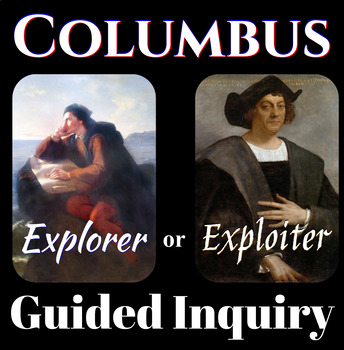Christopher Columbus: Explorer or Exploiter? DBQ and writing assignment
- Zip
- Google Apps™

Description
How should history remember Christopher Columbus? This tantalizing question has been a favorite for years. Pieces of evidence from both sides of the argument are offered to question this historic man's legacy as a master adventurer and salesman or as an exploiter of native populations.
The DBQ guided inquiry utilizes 12 quotes/ short passages from a variety of sources on Columbus and his legacy: everything from the Traditional Children’s Poem that heroizes him, historians who lauded him, to Howard Zinn’s less than favorable view of the legendary figure, a few of Columbus’ journal entries as primary documents, and even to textbooks from the 1800’s that function as their own primary sources for what students used to be presented with the story of Columbus. All these documents offer the opportunity to explore how historians shape people’s perceptions of the past through what they include in their stories or omit. Furthermore, each source has a few guiding questions to assist students in their understanding of the key terms and concepts. Other questions explore the nature of historical inquiry and the differences of what a text explicitly states, what it claims and what it implies.
Each year students come away from the activity with a variety of beliefs about Columbus even as the many shades of Columbus are colored. The guided inquiry packet can stand alone or be used with an included PowerPoint presentation, analysis of Social Institutions of Arawak society, and a number of resources to choose from. If you want to add a writing assignment to the investigation, there's a link to a Google Document that you can use in a Google Classroom as well. The main packet includes a PDF version if you don’t have Microsoft Publisher.
No matter how you choose to implement this lesson or how you assess it, students always enjoy debating about this topic and discussing the documents included.
Here's what's included in the Zipped Folder:
00 - Columbus: a bief introduction - PPT presentation
01 - Columbus DBQ
02 - Columbus: assessing documents & sources
03a - Social Institutions ( a short guided inquiry to introduce this concept and the categories that go with it)
03b - Social Institutions in the New World (a look at the culture of the Arawak Indians)
04 - Checking the Sources - a worksheet to rate the helpfulness, reliability and bias of each source
05 - Claims-Evidence-Reasoning Organization Worksheet
06 - Writing Template / Google Doc Template (There's a link in the Word Document to copy several different Google Doc Template Options)
07 - Self-assessment + Peer Review worksheet for students\
There is also a folder inside the main folder that includes some other resources and ideas (a worksheet to monitor a socratic seminar debate and excerpts from the testimony of Bartolome de las Casas) depending on how much time you want to dedicate to the discussion.
I hope you find this small unit enriching and rewarding for you and your students. There is now a Distance or Hybrid Learning version of the DBQ worksheets. It requires a free or paid account with GoFormative.com and syncs seamlessly with Google Classroom. That version is here.





